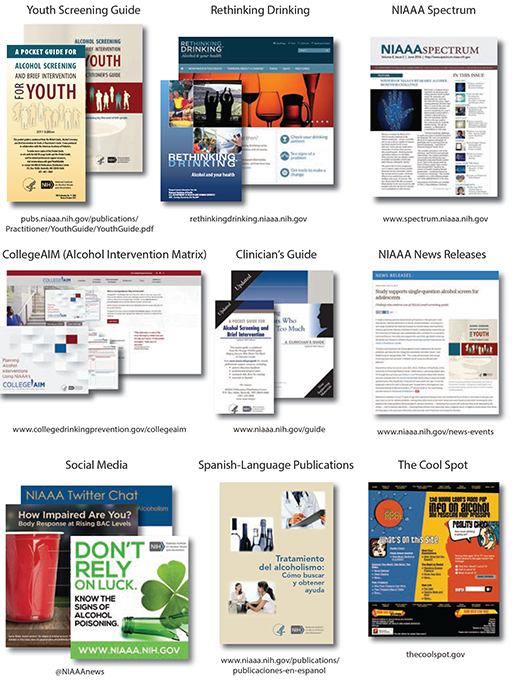Goal 5: Public Health
Enhance the Public Health Impact of NIAAA-Supported Research

The research supported by NIAAA has benefited people around the world by propelling advances in the diagnosis, prevention, and treatment of alcohol-related problems. While these achievements are notable, alcohol remains a leading contributor to death and disability. Although many people know that drinking too much can be bad for their health, they may not be aware of the full range of consequences associated with alcohol misuse, how alcohol exerts its adverse effects on the body, or how to prevent and treat alcohol-related problems. Likewise, although there is widespread acceptance among researchers and health care professionals that alcohol use disorder (AUD) is a chronic disease of the brain, this perspective may not be as widely accepted among members of the general public. A critical component of NIAAA’s mission, therefore, is to disseminate evidence-based information about alcohol and health to the public, health care providers, educators, researchers, and policymakers.
To improve understanding of the effects of alcohol on health in the United States and globally, NIAAA will pursue the following objectives:
Objective 5a: Improve public awareness of the effects of alcohol on health and well-being and of the options for preventing and treating alcohol misuse, alcohol use disorder, and alcohol-related problems for individuals at all stages of life
NIAAA has developed a robust communications and outreach program aimed at translating alcohol research findings for the benefit of public health. This is done through print publications for diverse populations, news media outreach, and an increasing focus on multimedia products and social media efforts. Each year, the Institute distributes approximately 600,000 alcohol-related publications to diverse audiences (see “NIAAA Print and Multimedia Products”), and more than 6.5 million people visit the NIAAA website. NIAAA’s Rethinking Drinking, a Web-based resource and accompanying booklet, is designed to help individuals who use alcohol assess their drinking habits and determine if they need to make a change. It also provides evidence-based information, tools, and support for cutting back on or quitting drinking. Treatment for Alcohol Problems: Finding and Getting Help, another resource developed for people interested in changing their drinking behavior, outlines behavioral and medication treatment options for AUD and provides tips for selecting among these options and sustaining recovery.
NIAAA develops resources tailored to specific populations. For example, to raise awareness of the effects of alcohol on women’s health and safety, NIAAA developed the brochure Alcohol: A Women’s Health Issue and its Women and Alcohol fact sheet. The Institute has also developed materials for adolescents, young adults, older adults, individuals with a family history of AUD, and parents, among others. To engage the nation’s growing population of Spanish speakers, NIAAA continues to expand its Spanish-language print products and social media efforts. The Institute is exploring opportunities to develop culturally appropriate products for other audiences as well, which will continue to be important as the demographic composition of the United States changes.
News media coverage of NIAAA research and related initiatives, which encompasses print publications, radio, television, and the Web, allows the Institute to expand its reach to the public. As such, media engagement remains a key component of NIAAA’s outreach strategy. The Institute serves as a credible source of scientific information and engages the media on alcohol-related issues through compelling news media packages that include images, infographics, and video and that provide opportunities to showcase the work of our scientific experts. These efforts are designed to increase media interest in—and dissemination of—the research and other initiatives that the Institute supports. To keep pace with changes in the way people seek and consume information, NIAAA will develop a broader array of multimedia products for multiple platforms that emphasize visual learning, the innovative use of graphics and videos, and interactive communications strategies.
To improve public understanding about the effects of alcohol on health and alcohol interventions, and to reduce the stigma associated with alcohol-related conditions, NIAAA will:
- Continue to develop and promote culturally appropriate, evidence-based materials for diverse audiences regarding the health effects of alcohol, AUD as a chronic disease, and options for preventing and treating alcohol-related conditions.
- Develop an AUD treatment navigator to help individuals with the complex process of evaluating, selecting, and pursuing appropriate treatment for AUD.
- Expand the use of state-of-the-art methods for sharing the latest research and health information with a wide range of audiences.
- Strengthen the capacity to work strategically with news media and other broadcast platforms to disseminate evidence-based information to a large and more diverse audience.
- Continue to assess NIAAA’s communications resources and strategies to determine if they are meeting their goals, and revise them accordingly.
Objective 5b: Develop and promote tools and resources to assist health care providers, researchers, and policymakers in addressing alcohol misuse, alcohol use disorder, and other alcohol-related health consequences
In addition to developing resources for individuals in need, NIAAA develops resources for professionals. Health care providers are on the front lines of alcohol prevention and treatment, yet many are unfamiliar with the full range of evidence-based alcohol interventions, and others may be uncomfortable using them. Following studies showing that alcohol screening and brief intervention (SBI) can reduce risky drinking among adults, NIAAA developed Helping Patients Who Drink Too Much: A Clinician’s Guide and Alcohol Screening and Brief Intervention for Youth: A Practitioner’s Guide to help health care providers implement SBI in their practices. Hundreds of thousands of copies of these guides have been distributed to doctors, nurses, and mental health practitioners. NIAAA also developed online training courses, based on the guides, with Medscape, an organization that provides research and health information for physicians and other health professionals. More than 20,000 providers have obtained continuing medical education credit for completing the Clinician’s Guide training, and more than 37,000 have received credit for completing the Youth Guide training. NIAAA’s College Alcohol Intervention Matrix (CollegeAIM), a research-based, interactive, user-friendly decision tool and guide designed to help colleges and universities address alcohol misuse on their campuses, is another example of a product developed for a specific professional group—higher education officials, particularly alcohol and other drug program and student life staff responsible for addressing student drinking on campuses.
Researchers and policymakers are also an important audience for NIAAA’s Alcohol Policy Information System (APIS) is designed primarily as a tool to facilitate research on the effects and effectiveness of alcohol-related policies, and it contains a wealth of information relevant to others interested or involved with alcohol policy issues. NIAAA is also collecting, reviewing, and evaluating the evidence-based, peer-reviewed literature on interventions to prevent and treat alcohol and other substance misuse among Native Americans and Alaska Natives. The findings will be made available to the public, and they are expected to facilitate additional research and guide tribal authorities in selecting interventions appropriate for their communities.
To assist service providers, researchers, and policymakers to address alcohol-related problems, NIAAA will:
- Continue to promote and disseminate evidence-based tools to assist professionals in addressing alcohol misuse across the lifespan and in diverse populations and settings.
- Develop, evaluate, disseminate, and validate evidence-based resources to facilitate the implementation of effective alcohol prevention and treatment interventions for special populations.
- Establish a publicly available database of measures employed in alcohol research that are available in languages other than English to facilitate alcohol research with diverse populations.
Objective 5c: Strengthen partnerships to extend the reach of the alcohol-related health information developed and distributed by NIAAA, and facilitate the implementation of evidence-based preventive and treatment interventions
Strategic partnerships play an increasingly important role in NIAAA’s communications efforts. NIAAA collaborates with other Federal agencies, scientific societies, professional and advocacy organizations, educators, and patient, family, and community groups, among others, on a wide range of initiatives. These partnerships extend the reach of the alcohol-related health information developed and distributed by the Institute, and they facilitate the implementation of evidence-based prevention and treatment interventions.
NIAAA is proud to have partnered with the U.S. Surgeon General and other U.S. Department of Health and Human Services agencies on Facing Addiction in America: The Surgeon General’s Report on Alcohol, Drugs, and Health. This comprehensive, first-of-its-kind report reviewed the state of the science of substance use and articulated an actionable set of recommendations for preventing and treating alcohol and other substance use disorders. NIAAA also collaborated with HBO on Risky Drinking, a powerful documentary that examines AUD through the intimate stories of four people whose drinking dramatically affected their lives. These initiatives, which were designed to provoke a national conversation about substance use, brought much-needed attention to the serious problem of alcohol misuse and showcased resources for addressing it.
NIAAA also partnered with the Substance Abuse and Mental Health Services Administration (SAMHSA) to raise awareness among health care providers about alcohol interventions. Together, the agencies convened a panel of experts in alcohol research, clinical care, medical education, and public policy to review the current evidence on the effectiveness of medications for the treatment of AUD. This initiative resulted in the development of Medication for the Treatment of Alcohol Use Disorder: A Brief Guide, which is designed to help clinicians incorporate pharmacotherapy into their alcohol treatment practices.
NIAAA, along with other NIH Institutes and Centers, SAMHSA, the Centers for Disease Control and Prevention, the Health Resources and Services Administration, and the White House Office of National Drug Control Policy, is engaged in a national initiative designed to grow the addiction medicine workforce and speed the integration of substance use prevention, early intervention, and treatment training into mainstream medicine. As part of this collaboration, NIAAA and its Federal partners are taking specific steps to improve physician training in substance use prevention and treatment, including supporting the accreditation of new addiction medicine fellowship training programs for residents and engaging medical education groups in designing and implementing national standards for training in addiction medicine.
Higher education institutions are also important partners in alcohol prevention and treatment. Recognizing that harmful and underage drinking are significant problems on U.S. campuses, NIAAA formed a working group composed of college and university presidents to bring renewed national attention to this issue. The College Presidents Working Group to Address Harmful and Underage Drinking requested a tool that would allow them to assess evidence-based college drinking interventions based on their effectiveness, anticipated costs, and barriers to implementation. In response to that request, NIAAA developed CollegeAIM. The Institute will continue to collaborate with the Working Group to organize regional workshops to introduce college and university officials to CollegeAIM and demonstrate how schools can use it, as well as develop a guide for parents about alcohol and their college students.
NIAAA also partners with a wide range of community organizations. These groups have provided valuable opportunities for NIAAA to learn from community leaders about emerging issues and gaps in alcohol research, prevention, and treatment, which informs the Institute’s research and communications efforts. Recognizing the value of community partners, NIAAA established the Senator Harold Hughes Memorial Award to recognize nonresearchers who translate research into practice. (See Senator Harold Hughes Memorial Award.)
NIAAA will establish strong partnerships with organizations that have the power to broaden and amplify its public health messages and effect real-world implementation of evidencebased interventions by pursuing the following objectives:
- Work with Federal partners that have a role in health care delivery to translate alcohol prevention and treatment research into practice.
- Continue to partner with professional organizations to integrate substance use prevention, screening and brief intervention, and treatment into primary care and preventive medicine training, and to develop an addiction “core curriculum” for medical student training.
- Continue to partner with community groups to broadly disseminate evidence-based information on alcohol and the prevention and treatment of alcohol-related problems.
- Partner with legal and criminal justice organizations to raise awareness of evidence-based alcohol treatment options in criminal justice settings.
- Explore opportunities to collaborate with human resources and other employee services organizations to raise awareness in the workplace about preventing and treating alcohol misuse and helping individuals access appropriate care.
Highlights
NIAAA Print and Multimedia Products

Senator Harold Hughes Memorial Award

The Senator Harold Hughes Memorial Award recognizes the contributions of a nonresearcher whose work translates research into practice and builds bridges between the alcohol prevention, treatment, and policymaking communities. The award is named for former Governor of Iowa and U.S. Senator, Harold Hughes, who was a major force behind the Comprehensive Alcohol Abuse and Alcoholism Prevention, Treatment, and Rehabilitation Act of 1970 that established NIAAA.
Previous Hughes Award recipients include:
Tom Donaldson, president and chief executive officer of the National Organization on Fetal Alcohol Syndrome (NOFAS), was recognized for his decades-long dedication to using current alcohol research to raise awareness about fetal alcohol spectrum disorders and the risks of drinking during pregnancy.
Jonathan Gibralter, Ph.D., president of Wells College, was recognized for his leadership in addressing the issue of high-risk drinking on the nation’s campuses through a community-based, multifaceted approach that brings together college administrators and key constituents on and off campus.
Marianne “Mimi” Fleury, president and co-founder of the Community of Concern (CoC), was recognized for her work to establish coalitions across the country to address underage drinking, smoking, and substance use and to develop science-based resources for parents, school administrators, counselors, and students.
General Arthur T. Dean, chairman and chief executive officer of Community Anti-Drug Coalitions of America (CADCA), was recognized for his leadership in promoting healthy, drug-free communities by engaging, supporting, and empowering community leaders around the nation to implement evidence-based substance use prevention, treatment, and recovery strategies.

